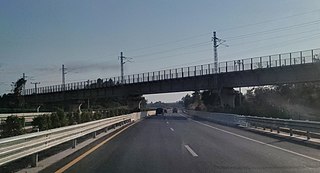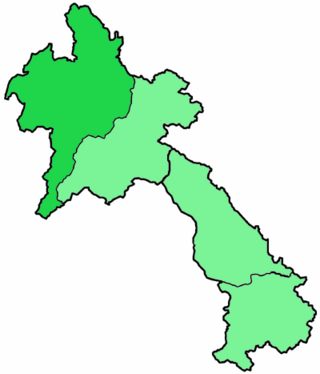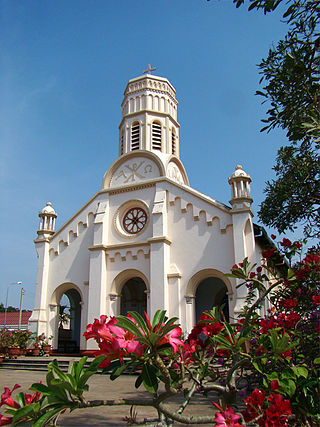| Part of a series on the |
| Catholic Church by country |
|---|
 |
| |
The Catholic Church in Laos is part of the worldwide Catholic Church, under the spiritual leadership of the pope in Rome. The Catholic Church is officially recognized by the government. [1]
| Part of a series on the |
| Catholic Church by country |
|---|
 |
| |
The Catholic Church in Laos is part of the worldwide Catholic Church, under the spiritual leadership of the pope in Rome. The Catholic Church is officially recognized by the government. [1]
There are no dioceses in the country. Rather, Laos is divided into four Apostolic Vicariates, [2] which are pre-diocesan jurisdictions that are entitled to a titular bishop and are exempt, i.e., directly subject to the Holy See and its missionary Congregation for the Evangelization of Peoples. The four vicariates are:
Each vicariate is headed by an apostolic vicar, who thereby is a member of the common episcopal conference of Laos and (Indochinese neighbour) Cambodia.
The Holy See has an Apostolic Delegation (papal diplomatic legation of lower rank than an embassy) to Laos. The delegation, however, is based in Bangkok, the capital of neighbouring Thailand. The papal legation to Laos is vested in the Apostolic nuncio to Thailand (as are also the papal legations to Cambodia and Myanmar).
On 4 May 1899, the Apostolic Vicariate of Laos was established on territory split off from the Apostolic Vicariate of Eastern Siam; it would be renamed on 21 December 1950 as Apostolic Vicariate of Thare, after its new see in Thailand, to become the present (Thai) Metropolitan Archdiocese of Thare and Nonseng.
The Apostolic Vicariate of Laos lost territories in two splits :
On 1 March 1963, the Apostolic Vicariate of Luang Prabang was in turn split off from the Apostolic Vicariate of Vientiane.
On 12 June 1967, the Apostolic Vicariate of Pakse was split off from the Apostolic Vicariate of Savannakhet).

In 2007 many Catholics were ethnic Vietnamese, concentrated in major urban centers and surrounding areas along the Mekong River in the central and southern regions of the country; the Catholic Church had an established presence in five of the most populous central and southern provinces, and Catholics are able to worship openly. [3]
The Catholic Church's activities were more circumscribed in the north, [3] where there were four bishops, two located in Vientiane and others located in the cities of Thakhek and Pakse. One of the two bishops resident in Vientiane oversaw the Vientiane Diocese and was responsible for the central part of the country while the second bishop resident in Vientiane was the Bishop of Luang Prabang - he was assigned to the northern part of the country, but while the Government did not permit him to take up his post, it did permit him to travel to visit church congregations in the north. [3]
Relationship between the Church and government has been strained since 1950s, a time when the Church was openly opposed to Pathet Lao. The relationship after 1975 is categorised as mutually suspicious within each other. [4] The church's property in Luang Prabang was seized after the 1975 Communist takeover, and there is no longer a parsonage in that city. [3] In 2007 an informal Catholic training center in Thakhek prepared a small number of priests to serve the Catholic community while several foreign nuns temporarily serve in the Vientiane diocese. [3]
There are 100,000 Catholics in Laos in 2022, [1] rising from 50,000 - 60,000 Laotian Catholics in 2015. [5]
Reports stated that 47 priests and 107 nuns served 180 parishes. [6]

Laos is a country in and the only landlocked nation in mainland Southeast Asia, northeast of Thailand and west of Vietnam. It covers approximately 236,800 square kilometers in the center of the Southeast Asian peninsula and it is surrounded by Myanmar (Burma), Cambodia, the People's Republic of China, Thailand, and Vietnam.

This article concerns the systems of transportation in Laos. Laos is a country in Asia, which possesses a number of modern transportation systems, including several highways and a number of airports. As a landlocked country, Laos possesses no ports or harbours on the sea, and the difficulty of navigation on the Mekong means that this is also not a significant transport route.
An apostolic vicariate is a territorial jurisdiction of the Catholic Church under a titular bishop centered in missionary regions and countries where dioceses or parishes have not yet been established. The status of apostolic vicariate is often a promotion for a former apostolic prefecture, while either may have started out as a mission sui iuris. It is essentially provisional, though it may last for a century or more. The hope is that the region will generate sufficient numbers of Catholics for the Church to create a diocese one day.

The Archdiocese of Thare and Nonseng is located in the north-east of Thailand. It is based in Tha Rae, a subdistrict municipality in the Mueang Sakon Nakhon district.

The Apostolic Vicariate of Pakse is a Latin rite missionary territorial jurisdiction of the Catholic Church in Laos. As an apostolic vicariate, it is a pre-diocesan jurisdiction, entitled to a titular bishop. It covers southern Laos.
Protestantism in Laos make up about 80% of the Christian population of the country in 2020.

The French protectorate of Laos was a French protectorate in Southeast Asia of what is today Laos between 1893 and 1953—with a brief interregnum as a Japanese puppet state in 1945—which constituted part of French Indochina. It was established over the Siamese vassal, the Kingdom of Luang Phrabang, following the Franco-Siamese War in 1893. It was integrated into French Indochina and in the following years further Siamese vassals, the Principality of Phuan and Kingdom of Champasak, were annexed into it in 1899 and 1904, respectively.

The Apostolic Vicariate of Savannakhet is a territorial jurisdiction of the Catholic Church in Laos. As an apostolic vicariate, it is a pre-diocesan jurisdiction, entitled to a titular bishop. It is located in central Laos.

The Apostolic Vicariate of Luang Prabang is a Latin Rite jurisdiction of the Catholic Church in Laos. As an apostolic vicariate, it is a pre-diocesan jurisdiction, entitled to a titular bishop. It is located in northern Laos.

Christianity is a minority religion in Laos.

The Apostolic Vicariate of Vientiane is a territorial jurisdiction of the Catholic Church located in northern Laos.

Theravada Buddhism is the largest religion in Laos.

Route 13 is the most important highway in Laos. It begins at Boten in northern Laos at the Chinese border. It connects the city of Vientiane to Luang Prabang in the north and roughly follows the line of the Mekong River down to the border with Cambodia. The road then continues at National Highway 7 in Cambodia. Route 13 passes the New Laos National Stadium at Vientiane prefecture and all three international airports in Laos Vientiane Airport, Luang Prabang Airport, and Pakse Airport. Between Boten and Nateuy a 20 km segment of Route 13 is part of the Kunming-Bangkok Expressway,. From Nateuy to Vientiane, Route 13 is part of AH12 and from Vientiane to the border of Cambodia, AH11. It roughly parallels to Vientiane-Boten Expressway.

Visitors to Laos must obtain a visa from one of the Laotian diplomatic missions or online unless they come from one of the visa exempt countries or qualify for visa on arrival. All visitors must hold a passport valid for 6 months.

Royal Air Lao was the national air carrier of the Kingdom of Laos that operated from 1962 to 1974.

The Co-Cathedral of St. Therese, also called St. Therese Cathedral, is the Roman Catholic Co-Cathedral located in the city of Savannakhet in southern part of Laos, near the border with Thailand.

The Martyrs of Laos are seventeen Catholic priests and professed religious as well as one lay young man venerated as martyrs killed in Laos between 1954 and 1970 of the First and Second Indochina Wars during a period of anti-religious sentiment under the Pathet Lao Theravada Buddhist-communist political movement.